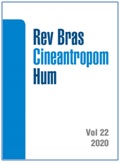Physiological demands of archery: effect of experience level
Abstract
The understanding of fatigue development during Archery competition would guide sports scientists, coaches and athletes on how to optimize the training routines of athletes from different competitive levels. This study investigated the effect of expertise level on physiological responses, during simulated archery competition (double-round 70m, 12 series, 6 arrows for an elite Brazilian Archer (EA) and a Novice Archer (NA). Ratings of perceived exertion, blood lactate and glucose, handgrip strength and electromyography were registered at the beginning, after each set from the 2nd to the 12tharrow and, 30-min after the competition simulation. The EA showed a greater handgrip strength for both arms, a constant lower mean RMS value (Baseline 0.279V and 12th set 0.221V, -20.7%), and a stable MF value throughout the competition (Baseline 146Hz to 12th set 140Hz). The NA showed a smaller handgrip strength, an increase in RMS after the 6th set towards the end of the competition (Baseline 0.387V, 6th 0.576V, and 12th set 0.720V, +46.2%) and a minor decrease in MF from the 6th to the end of 12th set (2nd set 122Hz, 4th set 127Hz, 6th set 112Hz and 12th set 117Hz, - 4.1%). In summary, all the fatigue-related markers showed a mild response to the Archery competition simulation, although a greater magnitude was observed in the NA, compared to the EA. This study reported the physiologic demands of an Archery simulated competition, in an official format, allowing coaches and sport scientists to draw more confident decisions on competition strategy and training design.
References
Leroyer P, Van Hoecke J, Helal JN. Biomechanical study of the final push-pull in archery. J Sports Sci 1993;11(1):63-9.
World Archery. World Archery Lausanne, Switzerland2016 [Available from: https://worldarchery.org/World-Archery.
Fitts RH. The cross-bridge cycle and skeletal muscle fatigue. J Appl Physiol 2008;104(2):551-8.
Mujika I. The alphabet of sport science research starts with Q. Int J Sports Physiol Perform 2013;8(5):465-6.
Borrensen J, Lambert MI. The quantification of training load, the training response and the effect on performance. Sports Med 2009;39(9):779-95.
Roberts SP, Trewartha G, Higgitt RJ, El-Abd J, Stokes KA. The physical demands of elite English rugby union. J Sports Sci 2008;26(8):825-33.
Borg G. Borg's perceived exertion and pain scales. Champaign, IL: Human Kinetics Publishers; 1998.
Squadrone R, Rodano R, Gallozzi C, editors. Fatigue effects on shooting archery performance. ISBS-Conference Proceedings Archive; 1994.
Tesch PA, Dudley GA, Duvoisin MR, Hather BM, Harris RT. Force and EMG signal patterns during repeated bouts of concentric or eccentric muscle actions. Acta Physiol Scand 1990;138(3):263-71.
Knaflitz M, Merletti R, De Luca CJ. Inference of motor unit recruitment order in voluntary and electrically elicited contractions. J Appl Physiol 1990;68(4):1657-67.



